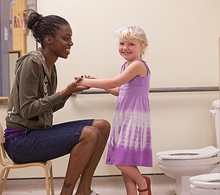 We face many challenges as parents, but toilet learning may feel like one of the more daunting ones. And now that your child seems old enough to begin toilet learning, you also wonder how toilet learning works in child care. Relax. Like every other aspect of child care, you and your child’s teacher will work as partners in the process of toilet learning. Toilet learning while in a child care or daycare setting may be easier than it is at home. At daycare, your toddler sees other children visiting the bathroom, which can create a powerful incentive and example. Teachers are usually very experienced in toilet learning and can offer you a lot of support. Many schools have toddler-sized toilets and sinks, which can make the process much less intimidating. Ask for the teacher’s insights, and try not to compare your child to other children in the center. Soon, your days of changing diapers will be over and your toddler will seem oh-so grown up.
We face many challenges as parents, but toilet learning may feel like one of the more daunting ones. And now that your child seems old enough to begin toilet learning, you also wonder how toilet learning works in child care. Relax. Like every other aspect of child care, you and your child’s teacher will work as partners in the process of toilet learning. Toilet learning while in a child care or daycare setting may be easier than it is at home. At daycare, your toddler sees other children visiting the bathroom, which can create a powerful incentive and example. Teachers are usually very experienced in toilet learning and can offer you a lot of support. Many schools have toddler-sized toilets and sinks, which can make the process much less intimidating. Ask for the teacher’s insights, and try not to compare your child to other children in the center. Soon, your days of changing diapers will be over and your toddler will seem oh-so grown up.
Tips for Toilet Learning at Daycare or Child Care
- Get on the same page. Talk with your child’s teachers about the approach they use. They can help you watch for signs of readiness. These signs may include staying dry for lengths of time, expressing an interest in using the toilet, and being able to pull clothes up and down. You and your child’s teachers will work together to develop a plan for toilet learning. Share your own philosophy and any concerns you have. Mutually agree on how you’ll handle toilet learning and make sure that you consistently follow the plan during the evenings and weekends.
- Communicate, communicate, communicate. An essential part of Premier Academy’s toddler care toilet training plan involves clear communication with our parents! We want to let you know what is working for us and we welcome any suggestions from you about what works best for your child. Let your child’s teacher know when your child last went potty when you drop off in the morning. Ask for the same information when you pick your child up at the end of the day, and read the Daily Experience Sheet for detailed information. Find out about the times your child uses the bathroom at school and try to duplicate this schedule at home.
- Come prepared. Accidents are bound to happen during the first few weeks of toilet learning, so make sure your toddler is prepared to cope with potty accidents. Be sure to send your child to daycare with plenty of clean clothes. Skip the onesies, blue jeans, or overalls, and opt for soft, loose pants with an elastic waistband. These clothes help your child be more independent, and they also simplify the inevitable changes. Send your child in shoes that come off easily and don’t forget extra socks.
- Expect setbacks. Toilet learning is a major developmental milestone in toddler care and it’s very common for children to make progress and then regress. Try not to get discouraged or express frustration to your toddler. Make sure that your child is really ready before you start toilet learning. The age of readiness varies from child to child, but most kids are ready to toilet learn between 20 and 30 months. Take it slow and use a relaxed, positive approach. Talk with your child’s teacher if you have questions or just need some extra support.
- Push the fruits and veggies. What does nutrition have to do with toilet learning? Constipation is a common problem when children don’t eat enough fiber. Children sometimes develop a fear of toileting if they’ve experienced painful stools. Eating fruits and vegetables helps keep their digestive system regulated.
- Accommodate special needs. A child with developmental or physical delays may need extra support to toilet learn. Talk with your child’s teacher about ways to help, which might include delaying toilet learning, using a visual chart, or practicing the steps of pulling down pants or washing hands prior to starting toilet learning.
As you go through the toilet learning process, try to keep perspective. Some children are very motivated and learn to use the toilet quickly. Others need more time before they completely master this developmental task. Remember that both you and your child are doing the best you can. Before long, your child will be diaper-free and ready for the next adventure.


